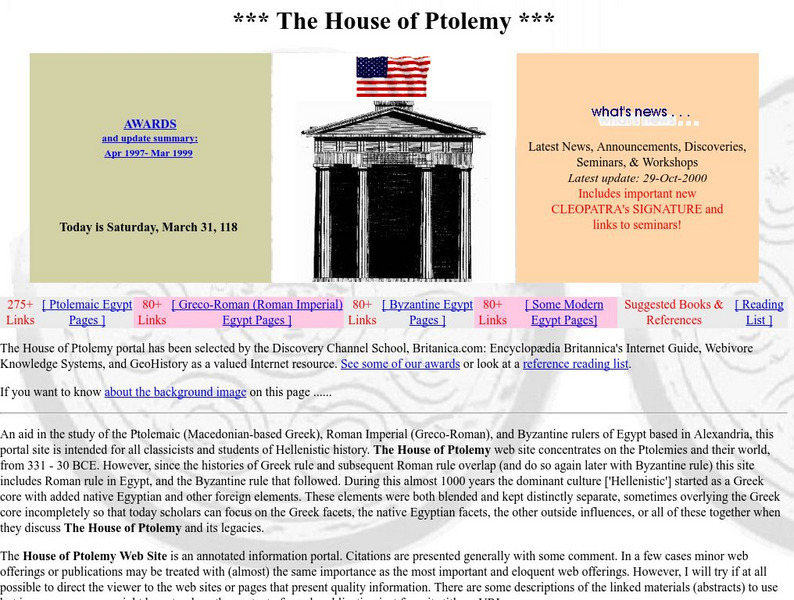Curated OER
Eternal Egypt: Tanis
Tanis' ancient Egyptian name is Djane, its Coptic name is San, the Zoan of the Old Testament. It became the capital of the Tanite kings of the Twenty-first and Twenty-second Dynasties. From that time, its strategic position and harbor on...
Curated OER
Eternal Egypt: Royal Head
The head of a man representing a royal figure; he is wearing the Nemes headdress and the Nemes knot appears behind the head. This statue was one of the objects that were found in the sea at Alexandria.
Curated OER
Eternal Egypt: Statuette of Harpocrates
A small statue made of faience representing Harpocrates, the child god in the trinity of Alexandria, is portrayed as a boy, resting on his right foot while the left one is unrestrained.
Curated OER
Eternal Egypt: Amphora From Rhodes
An amphora from Rhodes, it was found in the sea at Abu Qir near Alexandria. It is unusual in having a cylindrical neck and a pear-shaped body.
Curated OER
Eternal Egypt: Long Necked Amphora
This reddish amphora was found in the sea at Alexandria. It has a long neck and a conical body. Such vessels were made to contain liquids such as wine.
Curated OER
Eternal Egypt: Short Necked Amphora
This vessel has a large mouth, a short neck and two short handles. The rounded body is undecorated. It was found in the sea at Alexandria.
Curated OER
Eternal Egypt: Marble Bust of Serapis
Found at the Serapeum of Alexandria, the white marble bust of Serapis wears the kalathos, or sacred basket of mysteries. His head and beard are covered with thick curly hair, while five locks fall on his forehead.
Curated OER
Eternal Egypt: Skyphos With a Black Glaze
A drinking cup of skyphos style with a black glaze. Skyphoi were used for serving water or wine and were popular in the city of Alexandria during the Hellenistic era.
Curated OER
Eternal Egypt: Oil Lamps for Illumination
Four oil lamps from the Hellenistic period were found during excavations at the location of the Alexandria Library.
Curated OER
Eternal Egypt: Marble Head of a Philosopher
A marble head depicts a man, with short hair, a long beard, and a moustache. The form of the statue indicates that he is a philosopher from Alexandria, for the city was full of intellectuals and philosophers in the Hellenistic period.
Curated OER
Eternal Egypt: Stela With Pointed Acroteria
This stela was found in the monasteries west of Alexandria. A gable, in the center of a raised circular ornament, is situated over an oblong panel. On two sides, there are pointed acroteria, or small pedestals.
Curated OER
Eternal Egypt: Royal Head Made of Pink Granite
A carved royal head made of pink granite; it is dated to the Hellenistic period. The head is covered by a Nemes headdress, a small part of the nose is broken. This is one of the objects found among the sunken antiquities of Alexandria.
Curated OER
Eternal Egypt: Golden Coin of Ptolemy the First
The gold coin of Ptolemy the First was minted in Alexandria. On the obverse is the head of Ptolemy the First Soter with his long nose and prominent sideburns. On the reverse, the Ptolemaic eagle stands on a thunderbolt looking to the left.
Other
The House of Ptolemy: Home Page
An extensive directory of Internet resources related to the Macedonian Dynasty in Egypt.
Science Buddies
Science Buddies: Calculating the Circumference of the Earth
In this project, you will estimate the circumference of the earth, using a method developed about 2,200 years ago, by Eratosthenes, a Greek mathematician and the librarian of the great library at Alexandria, in Egypt.
Curated OER
Educational Technology Clearinghouse: Maps Etc: Delta of the Nile, 1916
A map from 1916 of the Nile Delta, showing the water courses of the delta, the Pyramids, Cairo, Alexandria, Rosetta, Damietta, and Port Said and Suez at the openings of the Suez Canal.
PBS
Pbs: Nova: Seven Wonders: Get Clued In
Site gives clues for students to figure out the Wonders. Choose the Wonder after the clues are given. Which of the Seven Wonders is the only one still standing today?
Curated OER
Educational Technology Clearinghouse: Maps Etc: Pre Colonial Africa, 1885
A map of the African continent prior to the Berlin Conference of 1885, when the most powerful countries in Europe at the time convened to make their territorial claims on Africa and establish their colonial borders at the start of the...



